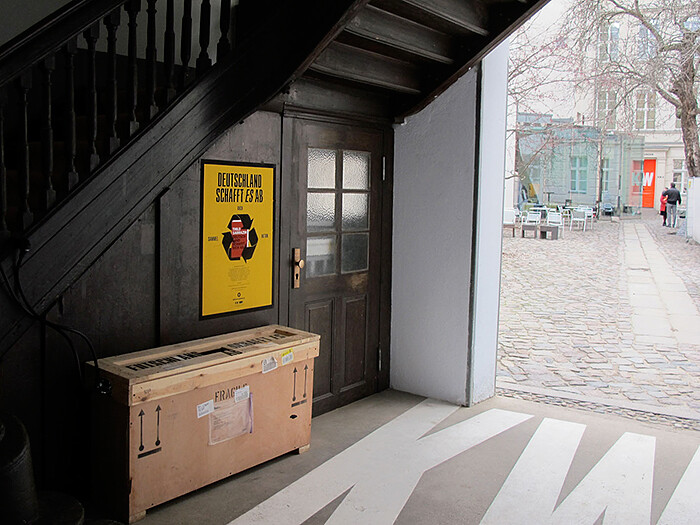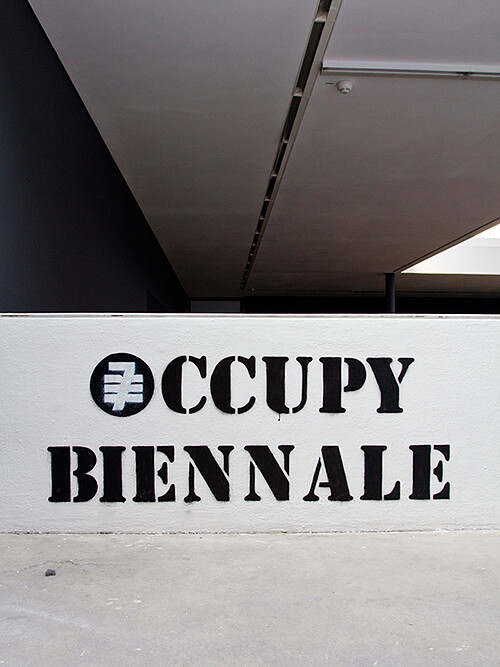“Forget Fear!” could be the title of Die Hard’s next installment. But it’s actually the title of the 2012 Berlin biennial. The parallels with the “good cop gone rogue” idiom are not accidental. The 7th Berlin biennial, curated by Artur Żmijewski in collaboration with associate curators Joanna Warsza and the group known as Voina seems to be caught in a pragmatic contradiction: it stands for left-wing positions through the enactment of right-wing methods and “vigilante” rhetorics.
The curatorial statement, written by Żmijewski—keeping with the spirit of the communications the biennial has been releasing—begins with a litany of complaints about the inadequacy of art and the weakness of its positions, expressed in a disillusioned, confessional tone, which mirrors the television trope of a lone hero battling a multitude of soul-less bureaucrats and single-minded apparatchiks. “I have been working in art, and in its cause, for years. It has become a way of life for me, life itself, and a passion. For years I have been observing its possibilities and limitations. But a few years ago I stopped ‘needing’ it. I used to like visiting galleries, anticipating the thrill that comes when you see reality filtered though the mind of an artist. Today, at such a sight I feel lassitude and a mood verging on depression. This is the result of repeated disappointment with artistic propositions.” One can almost see Clint Eastwood as Harry Callahan, after an embittered monologue, throwing away the badge he devoted his life to honor. If the analogy still doesn’t ring true, try re-reading the curatorial statement, putting the words “motherf*cker” in the end of every proactive sentence: “We were interested in finding answers, not asking questions, motherf*cker!”
Almost by definition, the Cowboy Cop is no team player. He sees the accepted institutions as corrupt, weak, and fundamentally compromised. He believes everyone else has “sold out.” His anti-establishment enterprise is rationalized by the notion that the channels at art’s disposal are left wanting when it comes to providing political “impact.” And “impact” is what the curators claim art should aim for.
Their obvious historical affiliation is to be found in the Futurist movement, which the Biennial explicitly—in interviews—and implicitly, evokes—most notably through its logo, reminiscent of both the Italian “Fasces” and Germanic runes. Futurism also glorified strength, and similar to the cowboy-cop character Żmijewski likes to play, it entrenches itself in a rhetorical distinction between “us” and “them.” Typically, they are “decadent” and we are “vigorous,” they are “dirty” and we are “pure.” The project by Czech artist Martin Zet “Deutschland schafft es ab” (Germany gets rid of it) provides a perfect illustration of this approach. Zet proposed to gather and dispose of copies of an infamously racist book, which created a furor in 2010: Thilo Sarrazin’s Deutschland schafft sich ab (Germany does away with itself). Whereas Sarrazin called for Germany to eliminate Muslim immigration, Zet, perfectly mirroring his tactics, called for Germany to eliminate Sarrazin’s book. Since “book removal and disposal” has weary connotations in Germany ( i.e., Bücherverbrennung) the project gathered a media storm much to the delight of the organizers. Like the Futurists, the Biennial welcomes criticism and hostile reactions, viewed as evidence of artistic vitality. Yet there is another pragmatic contradiction between what the biennial says it seeks to achieve— participation—and how it seeks to achieve it—confrontation. On the other hand, in a rather underwhelming public response, it seems only very few book copies were donated to the project. Unsurprisingly, the biennial pulled a sleight of hand—it claimed that though art can censor other forms of expression, art is itself above censorship: “It is my firm belief that the attack on Zet, the curators of Berlin Biennale, and KW, is in fact an attack on art” (Igor Stokfiszewski, on the BB website). One is left wondering whether this is the same “art” Żmijewski claims should be stripped of its immunity? Or is it that “art” apparently divides into two?
For Artur Żmijewski only one type of art seems unerring, the “applied social arts”. In a bid to exit from what the curators call the “alienation” of artistic autonomy, the biennial reaches out for an art of active engagement. Clearly, the only way forward is to erase the distinction between artist and spectator (since spectatorship is irredeemably passive), and to frame collective actions as artworks. The paradigm of “applied social arts”—to borrow the notion Żmijewski coined in a former article—wishes to see the multitude acting as one. The problems with this paradigm are well known however, namely that though it correctly “points right to the core of the question of the political, it does so by doing away with both art and politics” (Rancière, emphasis mine). To have all “all living bodies directly embodying the sense of the common,” —outside of a constituent function—is only possible under special conditions, and within highly codified settings, such as the rally, the protest, the procession or the ritual.
These said conditions the biennial doesn’t fail to recognize, lending a hand to a number of already-in-existence political movements such as the “Occupy” movement, to whom the ground floor of the KW (the major exhibition venue) is handed over. Here, however, the biennial relapses into yet another pragmatic contradiction, upholding the very distinctions it seeks to erase. If true art is the art of direct action, why are the “activist” artists neatly distinguished from the “artist” artists? Why is it that the logic of distribution of “speech” and “noise” inside the biennial so clearly dovetails with the logic of power outside the biennial?
Further, other than the Occupy movement, most of the works in the biennial, which manifest the ideals of “applied social arts,” reflect a preoccupation with ritual, ceremony or protocol. See for instance Born in Berlin and Final Fantasies by Joanna Rajkowska, or the Peace Wall project by Nada Prlja. Fittingly, the second floor of the KW hosts the model for a giant Jesus – Christ the King, a work in the making by Polish artist Miroslav Patecki. Łukasz Surowiec’s project Berlin-Birkenau transplants baby birches from around the former death camp of Auschwitz-Birkenau into private gardens in Berlin. The KW top floor is thus filled with vast swaths of the sprouts, and an ancillary video that is vaguely reminiscent of Claude Lanzmann’s Shoah (1985). Now, a ritual is a set of stylized actions, performed mainly for their symbolic value. Ritual is defined by a mode of symbolic structuring that removes the human from the clashes of antagonist history (political history) and places him on an altogether different type of temporality (the temporality of life, death, and natural cycles). That is, ritual re-inscribes human history back onto mythical history. The community structured by ritual is thus not a political community but an ethical community. Since ritual voids the political edge constituting one’s identity, one is no longer a Jew, German, nor Palestinian, just a man appearing as Man. The political difference that exists at the core and as the cause of any traumatic political event is evacuated by an all-encompassing piety, which can only maintain itself for as long as that same political difference remains suspended. All ritual is an appeasement, and is thus fully inadequate to express the sense of urgency present in political demands. The act of planting a tree to commemorate war victims speaks the language of Protocol. Planting trees is what first ladies do.
To revert art back to ritual is thus to lose sight of the modern tradition of critique. The political is not synonymous with politics. Critique is the acknowledgment of this split, or, as Bertolt Brecht put it, an awakening of a sense of strangeness that forces one to reshuffle the “order of things.” From the 7th Berlin Biennial however—excepting a few projects such as the project “Key of Return” by the Aida Refugee Camp community or those of Marina Naprushkina, Khaled Jarrar, Renzo Martens, and Pierre Bismuth—critique is altogether absent. The exhibition leaves everything in its proper place: speech and noise, power and protest, cruelty and kitsch. Like a deer caught in the headlights, the viewers become “bewildered recipients ineffectually looking for answers” (Żmijewski), yet this bewilderment is incapable of begetting political articulation, and, if anything, it reinforces the established order, or what Rancière called the order of the “police”. No wonder the show is gathering positive press, there’s nothing like copious amounts of discussion to mask the absence of discourse. Ironically, to such success Marinetti would retort that all that is “applauded immediately was certainly no better than the average intelligence and was something mediocre, dull, regurgitated or too well-digested.”
The most perplexing thing, however, is yet to come. Remember the film “Being John Malkovich,” in which one could slide through a trap door and into the body of John Malkovich? Remember how, when John Malkovich himself slides into John Malkovich, all he can see is John Malkovich? Well, upon entering the third floor of the KW the visitor might engage in a similar experience. Under the title “Breaking the News,” an ever-renewed multitude of short documentaries and activist videos is installed in an uncannily similar manner to Żmijewski’s own video installation Democracies (2009). To put it in more precise terms, Żmijewski remakes his own work through proxies. Through the hand of the curator the many become one, and that one is Żmijewski himself. Malkovich. Malkovich? Malkovich! To add to the overall mystification, the project located in the St. Elisabeth Church, the “Draftsmen’s Congress” initiated by Paweł Althamer, in which the visitors are invited to express their opinions by drawing on the inner walls of the Church, also shares uncanny similarities to yet another Żmijewski’s piece called Them (2007). Last but not least Żmijewski the curator curates Żmijewski the artist: his own video work Berek (1999) filming a game of tag by naked players inside a gas chamber, next to the Berlin-Birkenau project, is the show’s closing statement: Żmijewski. Żmijewski? Żmijewski!








